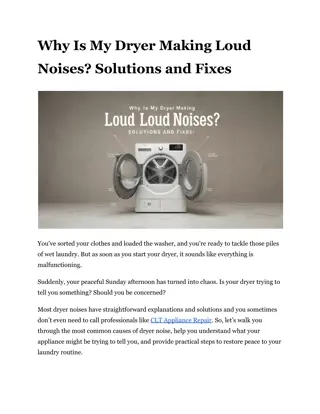
Dryer Fuse Issues_ Causes, Symptoms, and Solutions (GP6)
Learn why your dryer fuse keeps blowing, the signs to watch for, and simple solutions to get your dryer working again.
Download Presentation

Please find below an Image/Link to download the presentation.
The content on the website is provided AS IS for your information and personal use only. It may not be sold, licensed, or shared on other websites without obtaining consent from the author. Download presentation by click this link. If you encounter any issues during the download, it is possible that the publisher has removed the file from their server.
E N D
Presentation Transcript
Dryer Fuse Issues: Causes, Symptoms, and Solutions Dryer fuse issues are one of the most common problems that homeowners face with their dryers. A dryer s thermal fuse is a critical safety component designed to prevent overheating and potential fire hazards. When this small but essential part malfunctions, the dryer may stop functioning entirely or operate inefficiently. Understanding the role of the fuse, the reasons it might fail, and how to address the problem can save time, money, and frustration. What is a Dryer Fuse? The thermal fuse in a dryer is a safety device that detects overheating. If the dryer s internal temperature exceeds a safe level, the thermal fuse will blow, cutting power to the heating element or the dryer entirely. This feature is essential for preventing dangerous overheating conditions, which can lead to fires or significant appliance damage. Symptoms of a Blown Dryer Fuse If the thermal fuse is blown, you may notice one or more of the following symptoms: 1. Dryer Won t Start: A blown fuse will interrupt the dryer s electrical circuit, preventing it from starting.
2. Dryer Runs but Doesnt Heat: If the heating element is affected by the fuse, the dryer may tumble without producing heat. 3. Dryer Shuts Off Mid-Cycle: Overheating can cause the fuse to blow, cutting power mid-cycle. 4. Burning Smell or Excess Heat: In some cases, a failing fuse may coincide with signs of overheating before it blows. Identifying these symptoms early is crucial to minimizing damage and restoring the dryer s functionality. Common Causes of Dryer Fuse Issues Several factors can contribute to a blown dryer thermal fuse: 1. Blocked Ventilation: Lint buildup in the dryer vent or exhaust system restricts airflow, causing the dryer to overheat. Poor ventilation is the leading cause of blown fuses. 2. Clogged Lint Trap: A dirty lint trap can reduce airflow, leading to higher operating temperatures. 3. Overloading the Dryer: Operating the dryer with too many clothes can strain the system and cause it to overheat. 4. Defective Heating Element: A faulty heating element can overheat the dryer, triggering the thermal fuse. 5. Electrical Issues: Surges or electrical malfunctions within the dryer s circuitry may blow the fuse. Understanding these causes can help homeowners take preventive measures to avoid recurring problems. Solutions for Dryer Fuse Issues 1. Inspect and Replace the Thermal Fuse: Start by unplugging the dryer and locating the thermal fuse. It is typically found on the blower housing or near the heating element. Use a multimeter to test the fuse for continuity. If the fuse has no continuity, it needs to be replaced. Always use a replacement fuse that matches the manufacturer s specifications. 2. Clean the Dryer Vent System: Disconnect the dryer from the vent and thoroughly clean the ductwork using a dryer vent brush. Remove any lint or debris blocking the exterior vent.
Perform this maintenance regularly to prevent overheating. 3. Clean the Lint Trap: After every load, remove lint from the trap. Occasionally, wash the lint screen with warm, soapy water to remove fabric softener or detergent residue. 4. Reduce Dryer Loads: Avoid overloading the dryer to allow proper airflow. Follow the manufacturer s recommended capacity guidelines. 5. Check and Repair the Heating Element: If the heating element is malfunctioning, it may need replacement to prevent overheating. This task may require professional assistance if you are unfamiliar with dryer repairs. 6. Address Electrical Issues: Check for any loose or damaged wires in the dryer s circuit. Repair or replace wiring as necessary to ensure safe operation. Preventing Dryer Fuse Problems Regular maintenance and proper use of your dryer can help prevent fuse issues: 1. Schedule Routine Cleaning: Clean the dryer vent system and lint trap regularly to ensure optimal airflow. 2. Inspect the Dryer Periodically: Check for signs of wear and tear, such as frayed wires or overheating components. 3. Install a Lint Alarm: A lint alarm can alert you to clogs in the dryer vent system before they cause overheating. 4. Use the Dryer Efficiently: Avoid running the dryer for extended periods or drying heavy items in a single cycle. When to Call a Professional While some dryer fuse issues can be resolved with DIY solutions, others may require professional expertise. If you are unsure how to replace a thermal fuse or address the underlying cause, contacting a qualified technician is the best course of action. Final Thoughts Dryer fuse issues are a common yet manageable problem. By understanding the role of the thermal fuse, recognizing symptoms of failure, and taking preventive measures, you can ensure
your dryer operates safely and efficiently. Regular maintenance, such as cleaning the vent system and lint trap, is essential to avoid overheating and fuse problems. If you encounter persistent issues with your dryer, CLT Appliance Repairs Charlotte NC offers expert services to diagnose and resolve thermal fuse problems and other dryer-related issues. Their team ensures your dryer functions reliably, keeping your laundry routine on track. Site Article: Dryer Fuse Issues: Causes, Symptoms, and Solutions






















